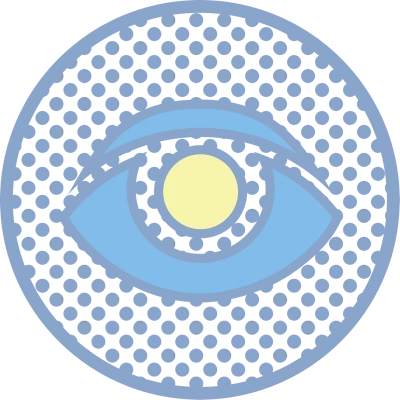What is Convergent Squint?
Also known as esotropia, this occurs when one eye turns inward towards the nose. It is common in children and may be due to high farsightedness or muscle imbalance.
Convergent squint Symptoms
- Noticed by the patient when the patient looks into the mirror or it is noticeable by others.
- The vision in the squinting eye may be less in some cases as compared to the normal eye. This is colloquially termed as Lazy Eye.

Convergent Squint Causes
-
Squint can be hereditary but not all family members may develop the same type.
-
Untreated far-sightedness: If you are far-sighted and not wearing glasses, constant strain on the eyes can force the eyes into becoming cross eyed.
-
Premature birth
-
Neurological disorders like hydrocephalus
-
Overactive thyroid gland-Hyperthyroidism
-
Diabetes
-
Stroke
Convergent Squint Risk Factor
-
Diabetes
-
Family history
-
Genetic disorders
-
Hyperthyroidism
-
Neurological disorders
-
Premature birth

Convergent Squint Prevention
Only in refractive type convergent squint; timely intervention with glasses will prevent further worsening of squint.
Convergent Squint Types
-
Congenital Esotropia:
when present at birth or within one year of life
-
Refractive Esotropia:
Due to hypermetropia or far-sightedness
-
Acute onset Esotropia:
Due to short sightedness and prolonged near work
-
Incomitant Esotropia:
Due to neurological disorders; vasculopathy secondary to metabolic disorders
-
Sensory Esotropia:
Due to poor vision
-
Esotropia associated with special strabismus like Duane Syndrome
Convergent Squint Diagnosis
-
Assessment of vision in each eye
-
Refraction to rule out refractive errors (power): myopia; hypermetropia; astigmatism
-
Assessment of angle of squint for distance and near using prism
-
Assessment of eye movements
-
Assessment of binocular vision and 3D vision
-
Assessment of double vision
-
Complete eye evaluation
Convergent Squint Treatment
-
In the case of Convergent Squint Treatment, upon diagnosis, surgical intervention is the preferred choice for doctors in almost all instances.
-
Congenital or infantile esotropia requires surgery or Botox injections into eye muscles
-
Refractive esotropia requires glass prescription; some may need bifocals
-
Acute onset esotropia may require surgery provided MRI brain scan is normal
-
Incomitant esotropia depending on the type, may require surgery; prism glasses or Botox injection
-
Sensory esotropia will require surgery for cosmetic reasons
Convergent Squint Complications
-
Loss of vision in one or both eyes
-
Binocular vision problems
- Double vision; loss of 3 D vision
In conclusion, the of Convergent Squint Treatment and other Eye Treatment is tailored to the individual’s needs and the severity of the condition. Early intervention, a comprehensive assessment, and collaboration between eye care professionals play a vital role in ensuring successful outcomes and improved visual function.
Written by: Dr. Manjula Jayakumar – Sr. Consultant Ophthalmologist, TTK Road
Frequently Asked Questions (FAQs) about Convergent Squint
What is convergent squint (strabismus)?
Convergent squint, also known as convergent strabismus or esotropia, is a type of eye condition where one eye turns inward while the other remains straight. This misalignment can occur either constantly or intermittently, affecting depth perception and visual clarity.
What are the causes of convergent squint?
The causes of convergent squint can vary widely and may involve factors such as genetics, abnormal development of eye muscles or nerves, refractive errors like farsightedness, or underlying health conditions such as cerebral palsy or thyroid eye disease. Additionally, issues with binocular vision or focusing abilities can contribute to the development of convergent squint.
How is convergent squint diagnosed?
Diagnosis of convergent squint typically involves a comprehensive eye examination by an ophthalmologist or optometrist. This examination may include tests to assess visual acuity, eye alignment, eye movements, and binocular vision. Specialized tools like a cover-uncover test or prism cover test may be used to determine the extent and severity of the squint.
What are the available treatment options for convergent squint?
Treatment options for convergent squint depend on factors such as the underlying cause, severity of the condition, and individual patient factors. Common treatment approaches may include corrective lenses to address refractive errors, eye exercises to improve eye coordination, patching or occlusion therapy to strengthen the weaker eye, and in some cases, surgical intervention to correct muscle imbalance and realign the eyes.
Can convergent squint be prevented?
While complete prevention of convergent squint may not always be possible due to genetic or developmental factors, early detection through regular eye examinations and prompt correction of refractive errors with glasses or contact lenses can help reduce the risk or delay its onset. Encouraging activities that promote good eye coordination may also support healthy visual development. However, since some cases may be influenced by factors beyond control, prevention strategies may not always be entirely effective. Early detection and appropriate management remain crucial in addressing convergent squint effectively.
This information is for general awareness only and cannot be construed as medical advice. Recovery Timelines, specialist availability, and treatment prices may vary. Please consult our specialists or visit your nearest branch for more details.Insurance coverage and associated costs may vary depending on the treatment and the specific inclusions under your policy. Please visit the insurance desk at your nearest branch for detailed information.

Do not ignore eye trouble!
Now you can reach our senior doctors by booking an online video consultation or a hospital appointment
Book an appointment now